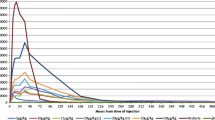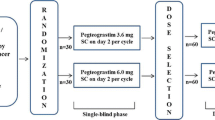Summary
Recombinant human granulocyte colony-stimulating factor (G-CSF) has been shown to reduce neutropenia following cytotoxic therapy, thereby enabling dose escalation to improve the response rate. It is important to know whether drug kinetics change as doses are increased. Doxorubicin was selected because of its broad spectrum of activity and its known efficacy in metastatic breast cancer. Doses of 75, 100, 125 and 150 mg/m2 were given to 11 patients with metastatic breast cancer by infusion over 30 min. Serum concentrations of parent drug and metabolites were determined during the first 48 h following the infusion by high-performance liquid chromatography (HPLC). The serum concentration vs time curve decayed as a triple exponential function in four patients and as a double exponential function in seven. A four-compartment model, one central and three peripheral, would predict concentrations to within 1 SE of the observed values. Doxorubicinol was the principal metabolite, and doxorubicinone and 7-deoxydoxorubicinone were clearly identified. There was a linear increase in the AUC∞ with dose. In addition, a small and transient increase in circulating levels of doxorubicinol and other important metabolites was observed 6 h following the administration of doxorubicin, which suggests the existence of an enterohepatic, or other, re-circulation mechanism. We conclude that in the dose range selected the kinetics of doxorubicin are linear and that the increase in toxicities seen with the higher doses of doxorubicin, following the second and third fortnightly administration, may be due to intracellular drug accumulation in tissues.
Similar content being viewed by others
References
Bachur NR (1975) Adriamycin (NSC-123127) pharmacology. Cancer Chemother Rep 6 (3): 103–108
Benjamin RS, Riggs CE, Bachur NR (1977) Plasma pharmacokinetics of Adriamycin and its metabolites in humans with normal hepatic and renal function. Cancer Res 41: 1416–1420
Box MJ, Davies D, Swann WH (1969) Non-linear optimization techniques. ICI monograph 5. Oliver and Boyd, Edinburgh, p 22
Bronchud MH, Howell A, Crowther D, Hopwood P, Souza L, Dexter TM (1989) The use of granulocyte-stimulating factor to increase the intensity of treatment with doxorubicin in patients with advanced breast and ovarian cancer. Br J Cancer 60: 121–125
Carter SK (1975) Adriamycin — a review. J Natl Cancer Inst 55: 1265–1274
Creasey WA, McIntosh LS, Brescia T, Odujinrin O, Aspnes GT, Murray E, Marsh JC (1976) Clinical effects and pharmacokinetics of different dosage schedules of Adriamycin. Cancer Res 36: 216–221
Crom WR (1986) Doxorubicin. In: Taylor WS, Caviness MHD (eds) A textbook for the clinical applications of therapeutic drug monitoring. Abbott Laboratories, Irving, Texas, pp 421–429
Durran JH (1970) Montecarlo method. In: Statistics and probability. Cambridge University Press, pp 8–9
Freedman LS, Workman P (1988) When can the infusion period be safely ignored in the estimation of pharmacokinetic parameters of drugs in humans? Cancer Chemother Pharmacol 22: 95–103
Gil P, Favre R, Durand A, Iliadis A, Cano JP, Carcassone Y (1983) Time dependency of Adriamycin and Adriamycinol kinetics. Cancer Chemother Pharmacol 10: 120–124
Greene RE, Collins JM, Jenkins JF, Speyer JL, Myers CE (1983) Plasma pharmacokinetics of Adriamycin and Adriamycinol: implications for the design of in vitro experiments and treatment protocols. Cancer Res 43: 3417–3421
Harris PA, Gross JF (1975) Preliminary pharmacokinetic model for Adriamycin. Cancer Chemother Rep 59: 819–825
Israel M, Pegg WJ, Wilkinson PM, Garnick MB (1978) Liquid chromatographic analysis of Adriamycin and metabolites in biological fluids. J Liquid Chromatogr 1: 795–809
Lee YN, Chan KK, Harris PA, Cohen JL (1980) Distribution of Adriamycin in cancer patients: tissue uptakes, plasma concentration after i.v. and hepatic i. a. administration. Cancer 45: 2231–2239
McIntosh JEA, McIntosh RP (1980) MODFIT: a general model-fitting program. In: Mathematical modelling and computers in endocrinology. Springer, Berlin, pp 250–260
Reich SD, Steinberg F, Bachur NR, Riggs CE, Goebel R Jr, Berman M (1979) Mathematical model for Adriamycin (doxorubicin) pharmacokinetics. Cancer Chemother Pharmacol 3: 125–131
Rodvold KA, Rushing DA, Tewksbury DA, (1988) Doxorubicin clearance in the obese. J Clin Oncol 6: 1321–1327
Wilkinson PM, Mawer GE (1974) The persistence of Adriamycin in man and rat. Br J Clin Pharmacol 1: 241–247
Author information
Authors and Affiliations
Rights and permissions
About this article
Cite this article
Bronchud, M.H., Margison, J.M., Howell, A. et al. Comparative pharmacokinetics of escalating doses of doxorubicin in patients with metastatic breast cancer. Cancer Chemother. Pharmacol. 25, 435–439 (1990). https://doi.org/10.1007/BF00686055
Received:
Accepted:
Issue Date:
DOI: https://doi.org/10.1007/BF00686055




